From the 1950s through the turn of the century, the Defense Department spent some $25 billion on numerous unmanned aircraft programs without ever coming up with an effective, operational air system deployed over a long period.
Today, though, US military forces employ thousands of remotely piloted aircraft (RPAs), and they fly in every theater of operation. Their growth has been nothing short of stunning—the military services logged more than 500,000 RPA flying hours in 2008, representing a 16-fold increase over 2002.
The systems provide a wide range of capabilities, from surveillance and reconnaissance and target identification and designation to strike and even tactical airlift. RPA capabilities are now resident in all combat components.
The Air Force, not surprisingly, possesses the most sophisticated inventory and has made the greatest investment in unmanned aircraft, with nearly 66 percent of all service RPA spending coming from Air Force accounts over the past decades.
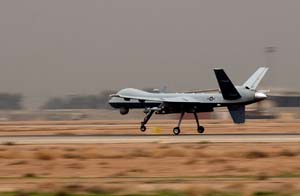 |
|
At present, USAF operates more than 180 medium and large unmanned aircraft as it builds toward a target of 65 continuous MQ-1 and MQ-9 orbits. It also operates a multitude of smaller aircraft, such as Wasp, for short-range support to special operations or air base defense missions.
Looking forward, the Defense Department is poised to spend tens of billions of dollars over the next decade on unmanned air systems of all types.
Why did these systems take off only recently? Why did each service go from a handful of RPAs in 2001 to inventories in the thousands today? Why, almost alone among military aircraft, do unmanned aircraft show promise of strong growth ahead
The reasons stem from the convergence of technological and operational factors. In the past, for instance, RPAs relied on inertial navigation systems whose positional error increased with flight time. The 1960s Tagboard RPA that launched from SR-71s and B-52s and the long-endurance Compass Dwell/Cope systems had marginal operational utility due to their meandering flight path.
Now, the Global Positioning System satellite constellation provides major gains. First, it can accurately determine the RPA’s location and, more importantly, establish the precise area on which a sensor is focused. With GPS allowing sensor operators to know the target’s location, the information can be disseminated to command centers and attack pilots quickly and efficiently. This allows the RPA to be relevant in combat operations.
That’s not all. Thanks to the growth of computational capabilities and advanced software development, engineers since the late 1990s have been able to design, develop, and manufacture RPAs with the inherent capacity to accomplish key tasks with greater effectiveness and safety. The miniaturization of computers allowed these aircraft to perform additional automated tasks within the size, weight, and power constraints of the vehicle.
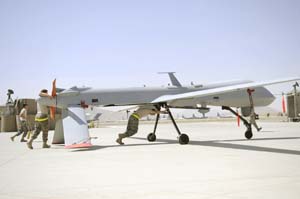 |
|
These software and computer developments allow RPAs to maneuver and perform without the pilot onboard. For instance, the Predator and Reaper, rated as Level Two on the Air Force’s nine-level autonomy scale (nine being the highest level of autonomy), are equipped with an autopilot. A pilot transmits “stick and rudder” commands to fly the aircraft, which requires constant communication between the aircraft and its ground station. If a Predator or Reaper loses its communication link, the aircraft goes into an airborne hold or can head back toward its base until communications are re-established or it runs out of fuel.
Advanced unmanned aerial vehicles such as the RQ-4 Global Hawk would be rated as Level Four on the autonomy scale. Pilots adjust flight path, altitude, and speed via premission planning inputs or with corrections on the mission management console during flight. The aircraft has the ability to address contingencies that arise and “decide” whether to continue or divert, return to base, and land.
Losses Decrease The aircraft’s systems constantly monitor its status and determine, through a rule-based architecture, whether to continue the mission or abort and divert when an anomaly is detected. Global Hawks have successfully landed following in-flight engine failures and “lost link” events without additional pilot inputs.
The increased availability of satellite communications and associated bandwidth also enhanced the ability to employ unmanned aircraft beyond the horizon. With previous RPAs, the reach or range of the system was typically limited to line of sight from the ground station. In addition, RPAs were limited to downloading sensor images using line-of-sight data links to ground stations, as insufficient bandwidth was available for over-the-horizon transmission.
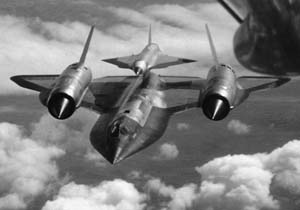 |
|
Today, the expansion of SATCOM removes such limitations and allows RPAs to operate beyond the horizon, opening an entirely new realm of possibilities. Medium and large remotely piloted aircraft rely on launch and recovery crews in theater, while pilots and sensor operators are typically in the United States, using satellite communications to provide flight inputs. The aircraft sends its sensor data through SATCOM.
By allowing the pilot to be removed from the cockpit, SATCOM allows an RPA, when persistence is needed, to remain on station significantly longer than most manned aircraft. Satellite control also means that fewer personnel must be forward deployed.
Often in the past, unmanned aircraft were seen as “disposable” air vehicles. The RQ-2 Pioneer had a mishap rate of 363 crashes per 100,000 flight hours early in its operational history. The RQ-5 Hunter mishap rate was 255 per 100,000 hours prior to 1996.
The first Predators were also low cost, and few cared if an air vehicle was lost to mechanical failure or hostile fire. This mind-set contributed to high loss rates, and so the MQ-1A Predator loss rate was 43 per 100,000 hours during the first six years of its operation.
These mishap rates are in stark contrast to the roughly two to three accidents seen per 100,000 hours by fighter aircraft, which had more robust development programs. In addition, the Air Force attributed a number of the Predator crashes during Operation Allied Force to the lack of spare parts and trained maintenance crews. Finally, operational commanders took risks with the unmanned system that they would not take with a manned aircraft.
Today, RPA loss rates have decreased as a result of higher experience levels and more rigorous acquisition programs. In the case of Global Hawk, loss rates are projected to become lower than the U-2’s rate—and on par with fighter aircraft.
Collectively, improvements in computational power and associated software, GPS for navigational accuracy, and SATCOM bandwidth provided the technological foundation for the expansion of remote aircraft and their effective integration into the joint force. But without new operational demands and innovative doctrinal concepts, attempts to integrate UAVs into the force would probably have met the same fate as those of the previous 50 years.
Nothing drives change more than the need to support combat operations when people’s lives are at risk. RPAs offered the ability to meet the operational challenges of combat in Afghanistan and Iraq in new ways.
Placing a pilot onboard the aircraft limits the sortie’s duration, particularly with a small, fighter-sized aircraft and limited cockpit space. In these conditions, the typical pilot duty day is 12 hours. With mission preparation (two hours) and debrief (one hour), sortie length for single seat aircraft such as the U-2 and many fighters can be constrained. In extraordinary circumstances, flight times can be extended, but this cannot be sustained on a routine basis without increasing the risk of pilot error.
RPAs are free of these human constraints. An RQ-4 can fly for about 32 hours, an MQ-9B for up to 28 hours.
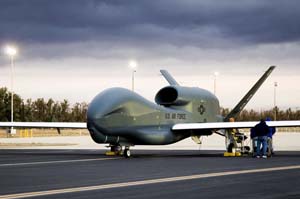 |
|
Concepts of operations for the unmanned combat air system, or UCAS, envision using aerial refueling to fly the system for 50 to 100 hours. Endurance translates into range, or time on station, or both. Longer range provides significantly greater flexibility with regard to basing locations and routing around other nations’ airspace.
Long-endurance aircraft are also able to maintain position much more efficiently than shorter-duration aircraft. For example, to maintain a 24-hour orbit, some 1,150 miles from base, with a Global Hawk requires one sortie. To do the same with a U-2 requires five sorties. In fact, for the total flying time required to maintain a U-2 over a 24-hour period (with five sorties), barely 50 percent of the flying time is spent on orbit; the rest is used in transit.
Persistent Stare While remotely piloted aircraft still need crews, personnel on the ground can “switch out” while the aircraft is on station and be replaced by a fresh crew.
In the past, aircrews monitored the data from wide-area surveillance sensors, while intelligence analysts exploited precise reconnaissance information. No matter what type of sensor employed, distinct training was required to interpret the data for commanders and combat troops.
The arrival of Predator and Reaper, with full-motion video cameras, changed this paradigm. Full-motion video allows ground forces to see without physically being present. The average soldier, sailor, airman, or marine can monitor the video and determine what is happening. The scene quality of current UAV sensors is sufficient to discern people with weapons or the types of activities people are doing (such as digging a hole and placing something into it such as an improvised explosive device).
As Army Maj. Gen. James O. Barclay III stated, “We can send a UAS [unmanned aircraft system] to look down alleys, around buildings, in backyards, or on a roof to see what’s up there, … a vital force multiplier in this era of persistent conflict.”
Given that the RPA’s sensor quality is not sufficient to determine who that person is standing on a rooftop or in the backyard, traditional intelligence-surveillance-reconnaissance sensors are also finding their way onto small UAS airframes. These additions are allowing signals intelligence or moving target indicator data to be rapidly fused with video imagery, increasing the commanders’ understanding of what is occurring. There is a parallel demand for semi-automated processing of such data, to allow the generic warfighter to accurately comprehend what is displayed. This is of paramount importance as the number of orbits being flown to support ongoing operations continues to increase.
The capability to watch an area on the other side of the world, persistently, in near real time, is something new. Given the nature of the fight against terrorism, it is also something enormously valuable.
Adding weapons to the persistent stare that unmanned aircraft offer has provided another important new capability: the ability to strike within minutes after locating a target.
During Operation Desert Storm, the Air Force began to make improvements in accelerating the kill chain, as it recognized the need to engage fleeing ground targets. During the Battle of Khafji, E-8 Joint STARS aircraft provided direct and accurate targeting information to A-10, F-16, and F-15E fighters, allowing them to intercept Iraqi armor formations.
Joint STARS combined wide-area surveillance with precise targeting information that allowed the air component to decimate hostile armor forces moving in the open. In other conventional and irregular conflicts, however, targets would not necessarily lend themselves to easy detection.
For instance, North Korea, immediately north of the demilitarized zone, maintains a number of hardened artillery sites from which it intends to rapidly move a gun into an open position, fire, and retreat back under cover.
During air operations over Kosovo, the A-10 airborne forward air controller used gyro-stabilized binoculars to find and identify enemy armor. The requirement to maneuver the aircraft often meant the AFAC’s eyes were taken off the target, however, and sometimes the target was lost.
The AFAC often found several potential hiding locations that were turned over to a Predator to “stare” at. The Predator’s optics were actually better than binoculars, improving confidence that the target was real and not a decoy.
During operations in Afghanistan, extended UAV presence allowed US forces to monitor a suspect’s location for hours, providing capability of exceptional value to find, “stare,” fix, and attack targets.
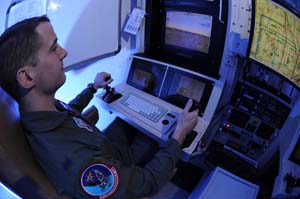 |
|
In a counterinsurgency or counterterror campaign, adversary leadership or other high-value targets may appear only momentarily from hiding locations, necessitating vigilance by the air component to fix and track during the rare opportunities. Once tracking, collateral damage or other concerns may prohibit an immediate attack, further increasing the demand for persistence.
As unmanned aircraft provided a sustained sensor presence, military leaders realized they could potentially provide the lethal striking power as well. As the former director of the Central Intelligence Agency noted in his memoirs, US officials found it very frustrating to see a target, such as Osama bin Laden, but not be able to engage in a timely manner. In the past, once a drone detected a target, command centers would need to locate a strike system and then vector an aircraft or cruise missile to the target. This could take from minutes to hours to days.
Evolving Threats Arming the Predator reduced the sensor-to-shooter times to minutes. The value of this capability has been routinely seen in strikes against terrorists in the Afghan-Pakistan border regions in recent years.
The rise of RPAs has taken place under the cover of air supremacy in a variety of conflicts over the past two decades. Permissive operational environments enable drone flights with no defensive suites and very limited maneuverability.
The benign environment is critical, as many RPAs are slow, easily detected on radar, and vulnerable to surface-to-air missiles, guns, and combat aircraft. During operations in Bosnia, a Serbian helicopter reportedly flew alongside a Predator MQ-1 and opened fire with door-mounted machine guns. In 2002, an Iraqi MiG-25 downed a Predator, highlighting the risk to small- and medium-size unmanned aircraft in contested airspace. Accordingly, against a moderately capable air defense network, RPAs could only operate in locations where US forces had established a degree of localized air superiority.
Another option is to exploit the aircraft’s ability to operate above 50,000 feet. Hostile fighter aircraft will have a difficult time engaging another aircraft at 60,000 to 70,000 feet, and only a limited number of SAMs reach that high. From this altitude, an RPA’s active sensors can reach more than 100 miles into hostile territory.
In the future, larger unmanned aircraft could employ air-to-air missiles and electronic attack techniques to improve survivability, potentially permitting persistent operations in an environment denied to today’s Reaper or Global Hawk.
Electronic attacks against command and control or sensor data links are an evolving threat to RPA operations. In late 2008, insurgents reportedly tapped into the unencrypted video links from Predator to monitor what the aircraft was seeing. More sophisticated jamming could slow the flow of data from sensors to control stations.
In addition, there is growing concern about GPS jamming. While higher-flying aircraft would be less affected by GPS jamming, lower and smaller RPAs could face significant challenges. Improvements to RPA connectivity and survivability will be required to ensure these capabilities remain available to US military forces while adversaries seek to deny them. Unmanned aircraft came of age during two decades when the US benefited from air superiority. Future foes might not be so accommodating.
Christopher J. Bowie has held a variety of positions with RAND Corp., the aerospace industry, and the Air Force. He is director of strategic studies for Northrop Grumman Integrated Systems. His last article for Air Force Magazine, “The Lessons of Salty Demo,” appeared in March 2009. Michael W. Isherwood, a retired USAF colonel and fighter pilot, is a senior analyst with the Northrop Grumman Analysis Center. His most recent article for Air Force Magazine, “Roadmap For Robotics,” appeared in December 2009.